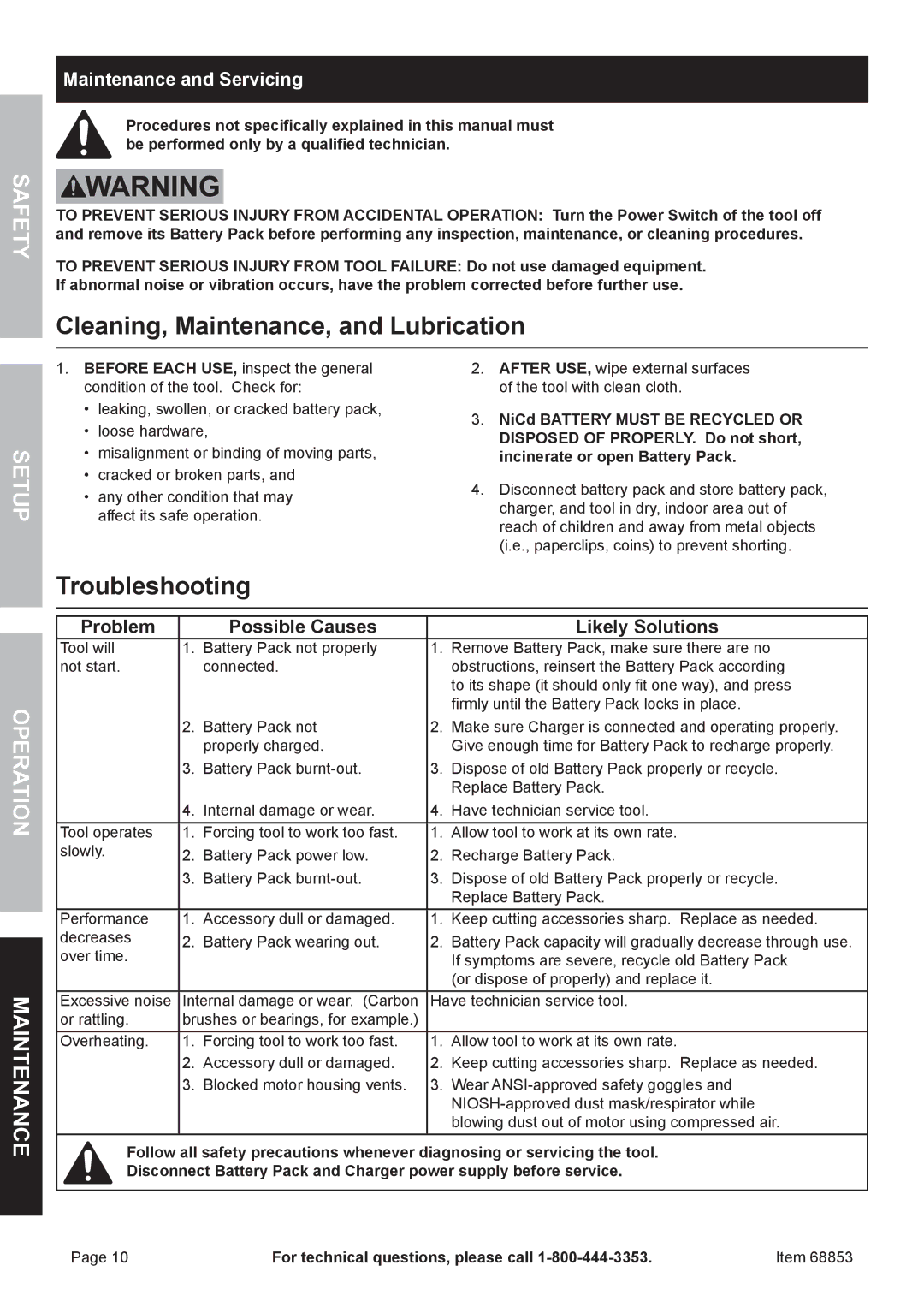
SAFETY
Maintenance and Servicing
Procedures not specifically explained in this manual must be performed only by a qualified technician.
TO PREVENT SERIOUS INJURY FROM ACCIDENTAL OPERATION: Turn the Power Switch of the tool off and remove its Battery Pack before performing any inspection, maintenance, or cleaning procedures.
TO PREVENT SERIOUS INJURY FROM TOOL FAILURE: Do not use damaged equipment. If abnormal noise or vibration occurs, have the problem corrected before further use.
Cleaning, Maintenance, and Lubrication
SETUP
1.BEFORE EACH USE, inspect the general condition of the tool. Check for:
•leaking, swollen, or cracked battery pack,
•loose hardware,
•misalignment or binding of moving parts,
•cracked or broken parts, and
•any other condition that may affect its safe operation.
2.AFTER USE, wipe external surfaces of the tool with clean cloth.
3.NiCd BATTERY MUST BE RECYCLED OR DISPOSED OF PROPERLY. Do not short, incinerate or open Battery Pack.
4.Disconnect battery pack and store battery pack, charger, and tool in dry, indoor area out of reach of children and away from metal objects (i.e., paperclips, coins) to prevent shorting.
OPERATION
MAINTENANCE
Troubleshooting
Problem |
| Possible Causes |
| Likely Solutions |
Tool will | 1. | Battery Pack not properly | 1. | Remove Battery Pack, make sure there are no |
not start. |
| connected. |
| obstructions, reinsert the Battery Pack according |
|
|
|
| to its shape (it should only fit one way), and press |
|
|
|
| firmly until the Battery Pack locks in place. |
| 2. | Battery Pack not | 2. | Make sure Charger is connected and operating properly. |
|
| properly charged. |
| Give enough time for Battery Pack to recharge properly. |
| 3. | Battery Pack burnt‑out. | 3. | Dispose of old Battery Pack properly or recycle. |
|
|
|
| Replace Battery Pack. |
| 4. | Internal damage or wear. | 4. | Have technician service tool. |
Tool operates | 1. | Forcing tool to work too fast. | 1. | Allow tool to work at its own rate. |
slowly. | 2. | Battery Pack power low. | 2. | Recharge Battery Pack. |
| 3. | Battery Pack burnt‑out. | 3. | Dispose of old Battery Pack properly or recycle. |
|
|
|
| Replace Battery Pack. |
Performance | 1. | Accessory dull or damaged. | 1. | Keep cutting accessories sharp. Replace as needed. |
decreases | 2. | Battery Pack wearing out. | 2. | Battery Pack capacity will gradually decrease through use. |
over time. |
|
|
| If symptoms are severe, recycle old Battery Pack |
|
|
|
| (or dispose of properly) and replace it. |
Excessive noise | Internal damage or wear. (Carbon | Have technician service tool. | ||
or rattling. | brushes or bearings, for example.) |
|
| |
Overheating. | 1. | Forcing tool to work too fast. | 1. | Allow tool to work at its own rate. |
| 2. | Accessory dull or damaged. | 2. | Keep cutting accessories sharp. Replace as needed. |
| 3. | Blocked motor housing vents. | 3. | Wear |
|
|
|
| NIOSH‑approved dust mask/respirator while |
|
|
|
| blowing dust out of motor using compressed air. |
Follow all safety precautions whenever diagnosing or servicing the tool.
Disconnect Battery Pack and Charger power supply before service.
Page 10 | For technical questions, please call | Item 68853 |
